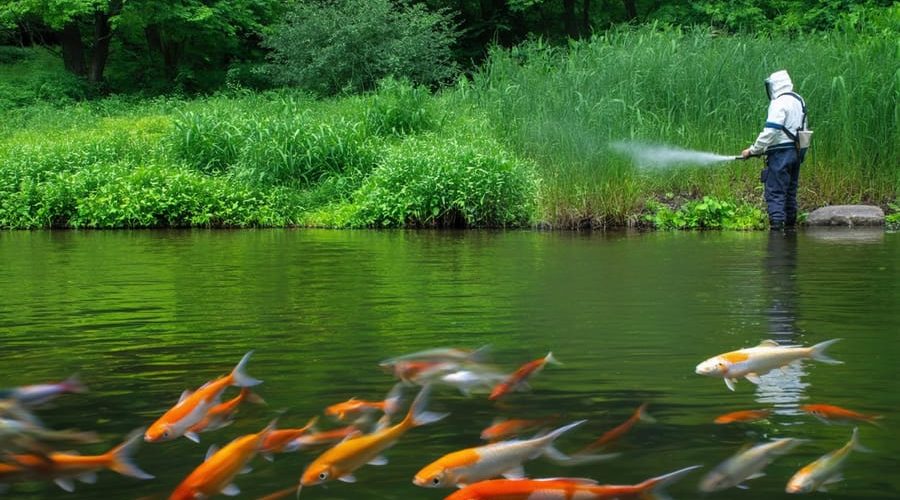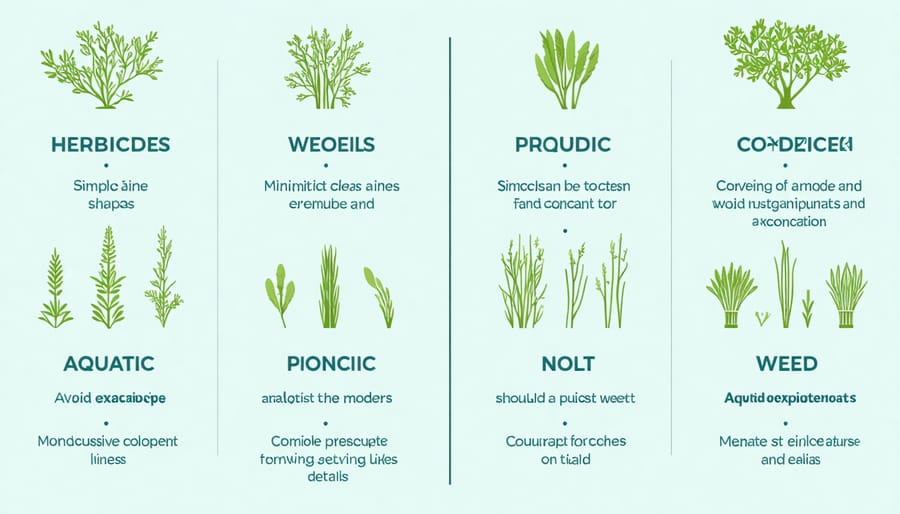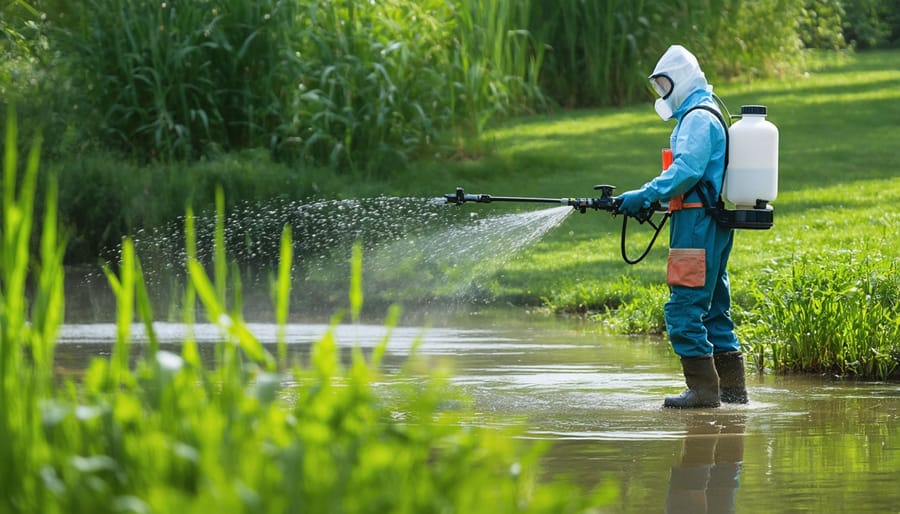
Safe Chemical Solutions That Keep Pond Weeds Under Control (Without Harming Fish)
Control aggressive pond weeds through precise chemical treatments applied during early morning hours when oxygen levels peak. Monitor water temperature and pH levels before adding EPA-approved aquatic herbicides to ensure maximum effectiveness while practicing responsible aquatic management. Strategically target invasive species by spot-treating affected areas rather than whole-pond applications, protecting beneficial plants and maintaining ecological balance. Install bottom barriers or pond liners in shallow zones to prevent weed root establishment, while maintaining proper nutrient levels to discourage excessive growth.
Physical removal complements chemical control – manually extract floating weeds and cut back submerged vegetation regularly. Introduce beneficial pond plants like water lilies to compete with nuisance weeds for nutrients and sunlight. Maintain proper circulation through strategically placed aerators and fountains, creating movement that discourages weed establishment while supporting healthy oxygen levels for fish and beneficial organisms.
Remember: Successful weed control requires consistent monitoring and a balanced approach that preserves your pond’s natural ecosystem. Early intervention prevents major infestations and reduces the need for aggressive treatments later.
Understanding Common Pond Weeds and Their Impact

Identifying Problem Weeds
Before tackling any pond weed issue, it’s crucial to correctly identify those problematic pond weeds. Common invaders include duckweed, which appears as tiny floating green dots covering the water surface, and watermeal, even smaller but equally persistent. Filamentous algae, often called pond scum, forms green, mat-like masses that can quickly overtake your pond.
Watch out for water hyacinth, with its distinctive lavender flowers and thick, glossy leaves – while beautiful, it’s highly invasive. Pond owners often struggle with coontail, recognizable by its dense, raccoon tail-like underwater foliage, and water milfoil, which forms feathery underwater branches.
Cattails, while native to many areas, can become overwhelming if not managed, especially along pond edges. Pay attention to unusual growth patterns or rapid spreading, as these are typical signs of invasive species taking hold. Remember, proper identification is your first step toward effective control and maintaining a healthy pond ecosystem.
How Weeds Affect Pond Health
Weeds in your pond are more than just an eyesore – they can seriously impact the overall health of your water garden ecosystem. When left unchecked, excessive weed growth depletes oxygen levels in the water, especially at night when plants compete with fish for oxygen. This can leave your fish gasping at the surface and stressed.
Dense weed patches also block sunlight from reaching deeper waters, preventing beneficial plants from thriving and disrupting the natural balance. As weeds die and decompose, they release nutrients that fuel algae growth and reduce water quality. This process can create a cycle of declining pond health.
Additionally, thick weed growth provides too much cover for small fish, making it harder for larger fish to feed naturally. It can also trap debris and create stagnant areas where mosquitoes breed. Some invasive weed species even release chemicals that inhibit the growth of other plants, further damaging your pond’s ecosystem.
However, it’s important to note that some aquatic plants are beneficial – the key is maintaining the right balance through proper management.

Safe Chemical Control Options
Contact Herbicides
Contact herbicides are the speedsters of pond weed control, delivering quick results typically within 24-48 hours of application. These fast-acting solutions work by destroying plant tissue on contact, making them ideal for tackling floating weeds like duckweed and watermeal that spread across your pond’s surface.
When using contact herbicides, timing is everything. Apply them on a calm, sunny morning when weeds are actively growing and there’s minimal wind to prevent drift. It’s crucial to treat only one-third of your pond at a time to maintain healthy oxygen levels and protect your fish. This approach also prevents the rapid decomposition of too many plants at once, which could harm your pond’s ecosystem.
Popular contact herbicides include diquat and endothall products, which are readily available at most garden centers. Before application, carefully read the product label and ensure it’s approved for your specific weed problem. Always wear protective gear, including gloves and eye protection, during application.
Remember that while contact herbicides offer quick results, they don’t address the root cause of weed problems. For lasting control, combine these treatments with preventive measures like proper pond depth and regular maintenance. Some weeds may require multiple treatments throughout the growing season for effective control.
To maximize effectiveness, consider using a surfactant with your herbicide, which helps the product stick to and penetrate weed surfaces better. Monitor your pond closely after treatment and remove dead plant material to prevent water quality issues.
Systemic Herbicides
Systemic herbicides offer a powerful, long-lasting solution for persistent pond weed problems. Unlike contact herbicides that only kill visible plant parts, systemic herbicides work by traveling through the entire plant, including the roots, ensuring complete elimination of unwanted vegetation.
When choosing a systemic herbicide, look for products containing active ingredients like fluridone or glyphosate, which are specifically designed for aquatic use. These herbicides are particularly effective against stubborn weeds like water lilies, cattails, and underwater grasses that tend to resist other treatment methods.
For best results, apply systemic herbicides during the growing season when plants are actively absorbing nutrients. It’s important to note that these herbicides work slowly, often taking several weeks to show full results. This gradual action actually benefits your pond’s ecosystem by preventing sudden die-off of vegetation, which could lead to oxygen depletion.
Always carefully measure and apply according to product instructions. Most systemic herbicides should be diluted and sprayed directly onto emerged weeds or distributed evenly across the water’s surface for submerged species. Remember to check local regulations, as some areas require permits for applying aquatic herbicides.
To maintain long-term control, consider combining systemic herbicides with other management methods like proper pond depth maintenance and regular monitoring. This integrated approach helps prevent weed regrowth and maintains a healthier pond environment.
Algaecides
Algaecides are a go-to solution for pond owners battling stubborn algae problems. These specialized chemicals work by disrupting algae cells, effectively clearing your pond water. Copper sulfate and copper-based products are among the most common algaecides, particularly effective against string algae and floating algae mats.
When using algaecides, always start with careful water testing and accurate measurements of your pond’s volume. A common mistake is using too much product, which can harm fish and beneficial plants. It’s best to treat your pond early in the morning when oxygen levels are highest, and always run aerators during treatment.
For best results, break up large algae masses before applying the treatment. This helps the algaecide work more effectively and prevents oxygen depletion from decomposing algae. Most treatments require multiple applications spaced about a week apart.
Remember that while algaecides offer quick results, they should be part of a broader maintenance strategy. Combine chemical treatments with proper filtration and regular cleaning to prevent algae from returning. Also, consider using natural bacterial supplements alongside algaecides to help break down dead algae and maintain better water quality.
Safety tip: Always wear protective gear when applying algaecides, and carefully follow the product’s dosing instructions. If you have sensitive fish like koi, choose products specifically labeled as safe for ornamental fish.
Application Tips and Safety Measures
Timing Your Treatment
Timing is crucial when treating pond weeds with chemicals. For best results, apply treatments in early spring when weeds first begin to grow but haven’t reached maturity. Water temperatures between 60-65°F are ideal, as plants are actively growing and more susceptible to treatments.
Avoid treating on hot, sunny days when oxygen levels are naturally lower, as this can stress fish. Instead, choose a calm morning when there’s little wind to disperse the chemicals. If you’re dealing with floating weeds, treat them when they’re clustered together rather than scattered across the pond.
Remember that multiple applications might be necessary, but always space treatments 10-14 days apart to prevent oxygen depletion. Late summer or fall treatments are less effective since plants are already preparing for dormancy and won’t absorb chemicals as readily.
Monitor weather forecasts before application – heavy rain can dilute your treatment, while strong winds can push chemicals to one area, potentially harming fish. For stubborn infestations, consider breaking your pond into sections and treating one area at a time to maintain safe oxygen levels.
Dosage Guidelines
Calculating the right amount of pond treatment is crucial for effective weed control while protecting your aquatic ecosystem. Start by measuring your pond’s volume in gallons – multiply the length x width x average depth (in feet), then multiply by 7.48 to convert to gallons.
For surface-floating weeds, measure the affected area in square feet (length x width) rather than total volume. Most liquid herbicides are dosed at 1-2 gallons per surface acre, while granular products typically require 20-40 pounds per acre.
Always read the product label carefully, as concentrations vary between brands. It’s better to start with the minimum recommended dose and add more if needed rather than risk overdosing. Consider treating just one-third of the pond at a time to maintain oxygen levels and prevent mass die-off of vegetation.
For spot treatments of small areas, use this simple formula: divide your treatment area by the total pond surface area, then multiply by the full-pond dosage amount. For example, if treating 1/4 of your pond, use 1/4 of the full recommended amount.
Remember that water temperature affects chemical activity – treatments work best when water is above 60°F. Always measure and mix chemicals at the pond’s edge, wearing appropriate safety gear. Keep detailed records of treatments, including dates, products used, and amounts applied.

Protecting Fish and Plants
When using chemical treatments for pond weeds, protecting pond life should be your top priority. Always carefully read product labels and choose treatments specifically formulated for pond use. Before applying any chemicals, test your water parameters and ensure proper oxygen levels, as some treatments can temporarily reduce oxygen content. It’s best to treat weeds in sections, covering no more than one-third of the pond at a time to prevent massive die-off that could harm fish.
Consider treating early in the morning when oxygen levels are highest, and keep an eye on your fish for signs of stress like gasping at the surface. If you notice any unusual behavior, immediately increase aeration and stop treatment. For valued ornamental plants you want to keep, create temporary barriers using plastic sheeting to prevent chemical contact.
Remember that some beneficial plants help maintain pond health, so identify your weeds correctly and target only problematic species. Running a fountain or aerator during treatment helps distribute chemicals evenly while maintaining crucial oxygen levels for your aquatic friends.
Maintaining Long-Term Control
After successfully treating pond weeds, the key to long-term success lies in maintaining pond health through preventive measures. Start by implementing a regular maintenance schedule that includes monthly water testing and debris removal. This proactive approach helps prevent future weed problems before they take hold.
Consider installing bottom barriers or pond liners in areas prone to persistent weed growth. These physical barriers prevent weeds from taking root while still allowing beneficial bacteria to thrive. Adding beneficial bacteria supplements monthly can help break down organic matter that would otherwise feed unwanted plant growth.
Proper aeration is another crucial factor in preventing weed regrowth. Installing a quality pond aerator or fountain keeps water moving and oxygen levels balanced, making it harder for nuisance weeds to establish themselves. Plus, moving water creates an environment where beneficial organisms can flourish.
Don’t forget about the power of beneficial plants! Strategic placement of native aquatic plants helps compete with unwanted weeds for nutrients. Water lilies, for instance, provide surface coverage that naturally shades the water, reducing the light available for weed growth. Aim to cover about 60% of your pond’s surface with these helpful plants.
Regular monitoring is essential – check your pond weekly for any signs of new weed growth and address issues immediately. Remember to maintain proper fish populations, as overcrowding can lead to excess nutrients that feed unwanted plants. Keep your filter system clean and functioning optimally, and remove dead plant material promptly to prevent decomposition from adding nutrients to the water.
By following these preventive strategies and staying vigilant with regular maintenance, you can enjoy a beautiful, weed-free pond year after year. Remember, a healthy pond ecosystem is your best defense against persistent weed problems.
Controlling pond weeds requires a balanced approach that combines proper planning, careful chemical selection, and responsible application methods. Remember that while chemical treatments can be effective, they should be used as part of a broader maintenance strategy that includes regular monitoring and preventive measures. Always choose EPA-approved products and follow dosage instructions carefully to protect your pond’s ecosystem. Consider starting with the least aggressive treatment options first, and only escalate to stronger chemicals when necessary. By maintaining proper water quality, managing nutrient levels, and implementing regular maintenance routines, you can keep your pond healthy and beautiful while minimizing the need for chemical interventions. Your pond is a living ecosystem – treat it with care, and it will reward you with years of enjoyment.
